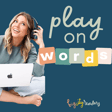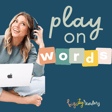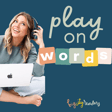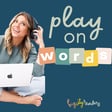Become a Creator today!Start creating today - Share your story with the world!
Start for free
00:00:00
00:00:01

ABC's - What Letters Should We Start With?
In this episode we dive into the essential foundations of early reading – teaching your child the ABC's! But where do we start? Alphabetical order? Backwards? One a week?
Miss Beth offers valuable insights and practical tips for parents, teachers and caregivers who are ready kickstart their child's reading journey and making it as easy as ABC.
Follow me on instagram: Instagram.com/bigcityreaders
Transcript
Introduction to ABC Teaching Methods
00:00:00
Speaker
Hi, everybody. It's Ms. Beth. Welcome back to the Play On Words podcast. Today, we're talking about what letters we should start with when you're introducing the ABCs. So if you follow me on Instagram at Big City Readers, you have heard me talk about this a lot, I'm sure. If you're newer, you can always send me a message on Instagram afterwards and ask for the posts if you want more visuals to go with what we talk about today.
00:00:29
Speaker
or as always send an email, hello at bigcityreaders.com.
Personalized Learning with Child's Name
00:00:35
Speaker
This episode will be short and sweet. We'll dive deeper into specific letters and how to begin to blend and build words with three and four or two letters together. But today we're talking about where we're gonna start. So the very best place to start.
00:00:56
Speaker
in teaching your child to recognize letters is going to be letters that they frequently see, like the letters in their name.
00:01:07
Speaker
We are always going to be talking about the letters in the child's name. That's the first word they're probably going to write. It's the most special combination of letters. If you've seen any of my spelling rules videos, you know that names are so special that they do whatever we tell them.
00:01:27
Speaker
We're talking about just recognizing and naming the letters right now. But if your child starts asking questions, you can say, this is your name. It's so special. And it doesn't follow any rules. You know, if you have a child named Charlie and they're saying, wait, but C says, then you say your name is so special that it doesn't, it doesn't follow any rules. All names are that special.
00:01:50
Speaker
It will depend on how much deeper you want to dive in beyond that, depending on your child's age and developmental reading and writing stage. If they are a bit older, they might be able to understand different types of patterns that their name might follow. But in general, I say names are so special. They get to be spelled however the person that named them chooses. So
00:02:19
Speaker
you're probably going to see your child's name a lot in preschool
Engaging Multi-sensory Techniques
00:02:24
Speaker
activities. If you're starting sooner, like with your toddler, this is the time to start to get them recognizing letters in their name. One of my favorite activities to do is to just, it's so easy, you just write their name on a piece of paper, stick it on the refrigerator,
00:02:41
Speaker
So this is a different kind of writing skill. We're using a different set of muscles in their hands and arms. So we're gonna, by having it not down on the floor or on a table, but up on the fridge. And then you can let them either peel stickers and just...
00:02:59
Speaker
the stickers around the letters that you've written in their name or give them a dot marker or one of those stampers and let them do that. When I'm very, very beginning stage introducing letters, I'm not going to do too much correction of we start at the top or we go, you know, let's use the name Charlie again, the C first, or I'm just going to let them
00:03:23
Speaker
feel it out, be exposed to the letters in their name. And then I might talk about it. That's your name. You might want to count the letters in their name together. And when you do this model moving from left to right, so we're going to let them count how many letters there are.
00:03:42
Speaker
You might name them C-H-A-R-L-I-E. Charlie, that's you. So the more and more they start to see it, the more they're going to say, that's my name. Those are my special letters. And if you've been around any preschoolers or older, you know, they might start to say, see, that's my letter. Whatever the first letter in their name is, they think is their letter.
00:04:08
Speaker
And they're right. Once your child starts to recognize and name some of the letters in their name, or maybe just starts to see their name a little bit more, we can start introducing more activities where they're going to be recognizing those letters. So that might look like writing the letters in their name
00:04:26
Speaker
all over a piece of paper and then just writing a few other letters, letting them either do finger paint and just put a little fingerprint on the letters that they find that are in their name. You can let that piece of paper that says their name be their example to try and find the match.
00:04:47
Speaker
you might then want to help them start to find matches. So maybe, maybe some of those dot stickers, take another piece of paper, put it on the fridge, take some of those dot stickers and write the letters in their name and then let them match them onto the letter on the piece of paper on the fridge. So if they have C, you know, there's going to be 10 stickers that say C and they could put all the C's on that C on the fridge.
00:05:16
Speaker
The goal here is to be hands on. So that means like we're letting them touch the letters. We're letting them play in a lot of different multi sensory ways. We want it to be fun. We don't want kids to feel overwhelmed or that we are being like, come on over. It's time to practice your name. You might even just have the activity up. And if they start playing with it, then you could say, those are the letters in your name.
00:05:41
Speaker
We need, it's really important, these neurons, especially in the first five years that are firing together and wiring together, we want them to be positive. So if your child has a negative experience because they really don't want to do it and you're like, let's just do it. It'll be good. You're going to learn. They're firing those two neurons, one, learning my letters and two, not having a fun time together. So that means that it's going to be a lot harder for them to overcome
00:06:07
Speaker
that down the road. So we want to make sure it's a really fun experience that we have and that it's repetitive. So making sure that we're not introducing other letters too fast. That doesn't mean we don't want to introduce letters. You'll know what your child is curious about or interested in, but it doesn't need to be like, okay, one letter per week. It doesn't need to be anything crazy like that.
Capital and Lowercase Letters Together
00:06:33
Speaker
If your child is a little bit older and is starting to write those letters, my favorite activity to do is to let them write their name in Plato using a pencil. So kids aren't ready to write every letter. We typically will see full progression by five and a half, but three and four year olds aren't able to write every letter. So don't push writing the letters if they aren't ready.
00:07:01
Speaker
You can let them form the letters with Plato if they want to practice forming the letters, but they might not be ready to write. And again, remember that firing together and wiring together. We don't want to force their hands to write when they're not ready if it's going to make them have a bad connection. So if they are ready, I like to add a little resistance because it can be a little bit tricky to navigate those growing fine motor skills.
00:07:29
Speaker
to use a pencil, so using a pencil in Play-Doh adds a little bit more resistance. I have about a hundred more learning the ABCs activities, so you can always send me a message and I will send you that. But then let's talk about what we do after the letters in our name.
00:07:47
Speaker
I typically like to introduce lowercase and uppercase at the same time. It depends on your child's age or stage, how much they're interested in it, but I like to do both at the same time. You can say uppercase, lowercase, you can say big and little, but we're going to introduce if we can at the same time. Now, they won't be able to write all of those lowercase letters because there's a lot more curves and our hands are still developing, but
00:08:17
Speaker
If you can and your child is really interested in their name, kids are usually going to be interested in something that has meaning to them and their name does have meaning to them. That's why we start with those letters. But if they're interested in more than the letters and their names, then go ahead and do some more. But I would say have them recognize their name with both uppercase and lowercase letters.
Continuous Sound Letters for Blending
00:08:40
Speaker
So letters then that we want to introduce, you know, there's tons of different people.
00:08:46
Speaker
with tons of different thoughts. But in my experience with working with a lot of families for a very long time, I used to say 20,000, but I can't keep track anymore. That was just based on a couple of stats of people that have ordered things from me or schools that I've worked with. But it's much more than that now, which is such an honor to me. But
00:09:11
Speaker
to get to help families learn how to read and it's such an important skill in life. So in my experience, I like to start next introducing a few letters. The ones I like to introduce are, well, there's a couple reasons. I like to introduce continuous sounds next. So we're gonna, I want them to start to recognize the letter and the sound. So a continuous sound
00:09:39
Speaker
is something that you can keep going until you run out of breath. Like the letter M says mmm. But the letter B, you can't keep going. It's b. You have to let the air out of your mouth for that sound. So that's a stop sound. It's easier to start to blend words if we start with a continuous sound. So that would be like a word like met. Mat.
00:10:04
Speaker
If we started with something like b, it'd be b-at. It's a little bit trickier for some kids. Another continuous sound is s-s. So some of the letters I like are m, s, a, i, n, t, and p. Those are some of the letters I like to introduce next.
00:10:29
Speaker
Easy to build some words, like word families like at and it with those letters or in. And then we can say, you know, set, pit. We want it to start to introduce letters. We don't want to wait to start to introduce blending of two to three letter words until they know all the letters. We want them to feel confident being able to blend with the letters that they do have a good understanding of. So that means, you know, they might,
00:10:58
Speaker
not know and recognize every letter, but if they have a very strong understanding, because we explicitly said, this is the letter, this is the sound, and we taught it in a multi-sensory way and in a fun way. And we've done that with eight letters. They can start to build those words. They might not be able to build them with their eyes, but you can start to say, I'll say it slow, you say it fast. Set.
00:11:29
Speaker
You might need to model this a few times before they start to understand it, but they might not recognize these letters, but start playing, I'll say it slow, you say it fast with the letters that you have explicitly taught and introduced to your child. Then you can just start to introduce the rest of the letters to your child.
Mastering Vowel Sounds with Resources
00:11:48
Speaker
I obviously have a class that will guide you in the right progression if you would like to take that. It's an ABC class, so if you have questions about finding that, you can send me a message as well.
00:11:59
Speaker
But we don't want to do too many at the same time, but we also don't want to do too few. So many people will do letter of the week. And I think that that's too few. I think that kids could do a couple letters at a time and really focus on building their strength around those letters. And we want to make sure that we don't steer away from the vowels. Before we go, I'm just going to tell you how to teach those vowel sounds, because I think this is
00:12:26
Speaker
Pretty tricky, even for us adults who do know how to read. Okay, the letter is A, the sound is A. The letter is E, the sound is E. The letter is I, the sound is I. The letter is O, the sound is A. And the letter is U, the sound is U.
00:12:48
Speaker
All of those letters I have a visual for on my Instagram, so go ahead and check over on Big City Readers to see that. But we want to make sure that we are saying the vowels the right way from the very beginning and saying all of the letters the right way from the very beginning.
00:13:05
Speaker
I actually am going to do the whole alphabet before we go. Um, and then if you have any more questions on specifics on anything that we talked about today, please email me or send me a message. I love to dive deeper with you here in the podcast. Okay. A B C D E F G H I J K L M N
00:13:36
Speaker
N-O-R-P-Q-R-S-T-U-V-W-X-X-Y-Z. I know it's a little tricky to hear all that, so I have a couple videos and of course it's in my ABC course as well.
00:14:00
Speaker
Thanks you guys for this amazing question and please, please, please reach out if you have more questions on specifics around the ABCs. I love to answer those. I had a friend, I've done so many podcast episodes about talking about sight words and I had a friend call me the other day to ask specifically about the sight word the and how to teach it. And I was like, she's like, sorry, this is probably so annoying. And I said, this actually is so helpful because I want to be able to break it down really
00:14:28
Speaker
specifically and clearly. And sometimes I just, it's too broad to talk about such a big thing like the letters or the sounds or phonological awareness or sight words or high frequency words.
00:14:39
Speaker
But when you share your really specific questions, I guarantee you at least 100 people
Engage with Questions and Community
00:14:45
Speaker
that listen to this also have those questions. So please, please, please send them. And thank you so much for rating and reviewing and sharing this podcast. It means so much to me and I love getting to know all of you in this way. I'll see you next time.



